Bangladesh’s clothing exports to the US grew by 36.4% to $9.75 billion year-on-year in 2022, according to the latest data from the US Office of Textiles and Apparel (Otexa).
The Otexa data showed that Bangladesh’s current share in the US market is about 9.8% (of the nearly $100 billion worth of clothing the US imported globally), meaning one in every ten garments exported to America from around the world originated from Bangladesh.
Bangladesh’s apparel exports to the United States have been growing steadily, despite not having duty benefits from the world’s largest market, as its market share stood at 8.2% in 2020 and 8.8% in 2021.
Exporters attributed the country’s strong performance in the US apparel market largely to its ability to quickly adapt to changing consumer trends and demands.

Bangladesh has become known for its ability to produce fast-fashion items in a timely and efficient manner, which has helped to build its reputation as a reliable supplier to American retailers.
However, despite Bangladesh’s growth in the US market outpacing that of its rivals China and Vietnam (10.8% and 27%, respectively), their exports in terms of monetary value still far surpass that of Bangladesh.
This highlights the importance of Bangladesh continuing to focus on increasing its competitiveness and improving the quality of its exports in order to increase its market share and capture a larger portion of the lucrative US market, an analyst told The Business Standard (TBS).
Md Anwar Shahid, the vice president of the Bangladesh Garment Buying House Association (BGBA) told TBS, “This growth was expected as we are mainly exporting woven products, any textile formed by weaving, to the US market, which is made of the imported costly fabrics.”
“The prices of major apparel items (shirts and trousers) that go to the US from Bangladesh are comparatively high,” he said, adding that Bangladesh became the top denim garments exporter in 2021.
“Besides, the US is less affected by the global economic recession than the European market, and that is why this market growth is better,” said Anwar Shahid, who is also the managing director of Shimex International Ltd – a globally recognised apparel agent.
Bangladesh also received a good number of orders shifted from China and Vietnam as every exporting country had suffered during the pandemic but only Bangladeshi apparel exporters had kept their units running at that time, which also helps them to enhance buyers’ confidence as a reliable sourcing destination, he said.
“Some high-value apparel buyers are also shifting from China to Bangladesh due to geo-political reasons,” he said.
DBL Group Vice-Chairman MA Rahim said, in the last six months, his group has started production of some high-value apparels for some luxury brands like Ralph Lauren, which has shifted their sourcing from China.
Currently, the company is producing some apparel items at retail prices of $200-$250, and the Free On Board (FOB) prices are also a few times higher than other conventional items, he said.
Bangladesh Garment Manufacturers and Exporters Association (BGMEA) President Faruque Hassan said the growth of apparel exports to the US market was very inspiring as Bangladeshi suppliers gained the confidence of global buyers amid a supply chain disruption caused by the Russia-Ukraine war and the pandemic.
Amid the global economic slowdown, Bangladesh’s apparel export earnings increased as unit prices increased due to the raw materials price hike, he said.
Besides, Bangladeshi apparel exporters are also ramping up shipments of value-added products, Faruque said.
“A shirt which was once exported at a price of $8-10, is now being exported at $12-14 due to price hike of raw materials. It is reflected in the growth,” the BGMEA chief said, adding that local entrepreneurs are now getting more orders of high-value products due to improved efficiency and technology adaptation.
















